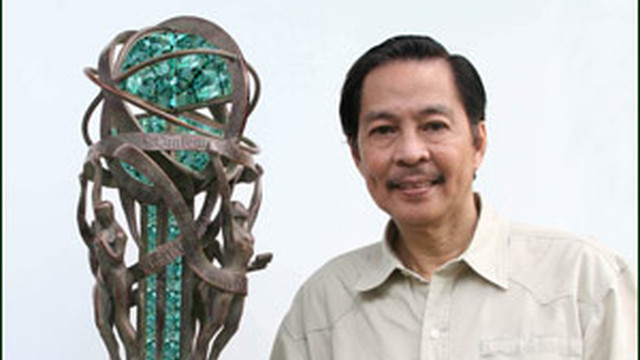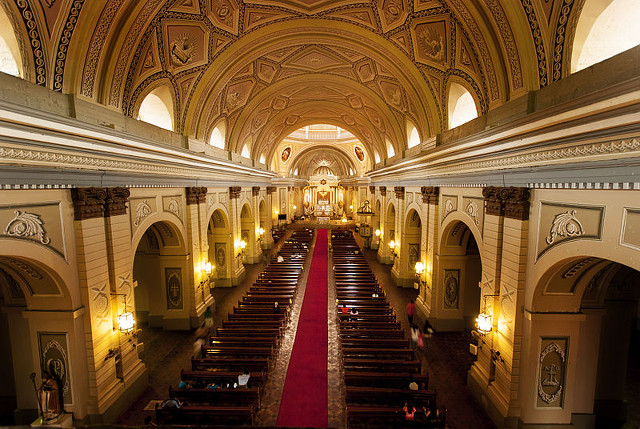SUMMARY
This is AI generated summarization, which may have errors. For context, always refer to the full article.
[See original image here]
MANILA, Philippines – A parish priest’s plan to build an events venue beside a historic church dashes hopes for a UNESCO World Heritage Site declaration.
This is the fear driving artist Ramon Orlina’s campaign to “preserve the antiquity and beauty” of Taal Basilica, also known as Basilica de San Martin de Tours. (Editor’s note: We earlier reported that Orlina is a National Artist. He’s not. We regret the error.)
The world-famous artist known for his crystalline, modern glass sculptures, is back in his hometown of Taal, Batangas to oppose the construction of an arcade which he believes will ruin the chances of the basilica and the entire town of Taal to be declared a World Heritage Site, a declaration he and his family have been working towards for years.
Taal Basilica, said to be the biggest Catholic church in Asia, is the centerpiece of the heritage town of Taal. To tourists in the know, Taal is the “Vigan near Metro Manila.” Like Vigan, which was declared a UNESCO World Heritage Site in 1999, Taal boasts beautiful Spanish-era mansions, churches and a fascinating history.
“Taal was founded in 1571, only one year after the founding of Manila which makes it one of the oldest towns in the country,” Orlina told Rappler during a phone interview.
Taal Basilica is one of the glorious remnants of the town’s history. Completed in 1878, it features a gigantic Doric-style main altar measuring 79 feet by 33 feet. The tiles in its baptistery were imported from Europe. Its majestic ceilings are painted in the trompe-l’œil style, an art technique dating back to the Baroque era in which painted imagery is made to look 3-dimensional. The church’s ancient bell is also one of the largest of its kind in Asia.

[See original image here]
A priest’s ‘racket’
A two-storey events venue called the Casa San Martin II Jubilee Hall will soon rise on the left side of the basilica if Taal parish priest Alfredo Madlangbayan has his way.
The structure, designed to mimic an ancient Roman arcade, will be a multipurpose events venue where wedding receptions, debuts, conferences and church meetings can take place. As of writing, construction of the hall’s first level is almost complete.
“Two months ago, I visited the basilica for a photoshoot. That was the first time I saw the construction,” said Orlina.
After seeking out Madlangbayan, his friend, Orlina found out that the arcade was Madlangbayan’s project. In fact, he recalls the priest referring to it as his “new racket.”
But the construction of the arcade was not approved by the National Historical Commission of the Philippines (NHCP), a requirement given the arcade’s proximity to the Taal Basilica, a National Historical Landmark.
According to Presidential Decree 1505,”It shall be unlawful for any person to modify, alter, repair or destroy the original features of any national shrine, monument, landmark and other important historic edifices” declared as National Historical Landmarks without the prior written permission from the NHCP Chairman.
It also apparently violates Republic Act 10066 or the National Cultural Heritage Act of 2009 which states “all intervention works and measures on conservation” of National Historical Landmarks “shall be undertaken through the appropriate cultural agency which shall supervise the same.”
Being only 1.5 meters away from the basilica, the arcade also flouts the rule in the Heritage Act that says real estate development is only allowed outside the 5-meter buffer zone surrounding historical landmarks.
A distraught Orlina, supported by members of the Taal Church Historical Authentic Restoration Movement (Taal CHARM), wrote to NHCP Chairperson Maria Serena Diokno about the illegal structure. After an October 11 inspection by the NHCP’s technical team, Diokno wrote to Madlangbayan saying “the construction and development plan should have been presented to us for our approval before any construction took place.”
Madlangbayan should have secured the approval of the NHCP which is mandated by law to give recommendations on projects like the Jubilee Hall and ensure its construction uses only methods and materials that strictly adhere to international standards.
Authenticity vs aesthetics
The heritage laws were created because the government recognizes the importance of authenticity when preserving historical landmarks.
The Heritage Act states that in heritage zones, “the appearance of streets, parks, monuments, buildings, natural bodies of water, canals, paths and barangays within a locality shall be maintained as close to their appearance at the time the area was of most importance to Philippine history.”
The “authenticity” of Taal Basilica is what Orlina is fighting for.
Because the construction of the arcade pushed through without the guidance of the NHCP, several design elements threaten to destroy the authenticity of the church.

[See original image here]
Looking at the arcade’s blueprint given to him by Madlangbayan, Orlina noted that “there is no historical basis for the design of the arcade.” Its Roman design, inspired by the aqueducts of the ancient Roman civilization, clashes with the basilica’s “Augustinian architecture.” Its lighting fixtures and tiles belong to the wrong era, he said.
The arcade, which is designed to look like a “fake ruin,” also “protrudes further out than the facade of the Basilica which should not have happened,” Orlina wrote to NHCP.
Worse, the arcade’s huge size threatens to crowd the Basilica’s grounds and block off the church’s left side.
‘Rubbish’
Rappler sought Madlangbayan’s side but he declined to comment. In a text message, the priest said, “God will take care of me. Don’t worry about me. Jesus was treated worse than me. That’s part of our mission to save this world full of sins and lies! God bless!”
Referring to Orlina, he said, “He is rubbish to me. Non-existent! A UFO!”
Some would call Orlina’s concerns trivial, but he maintains that authenticity is more than mere aesthetics.
“Taal Basilica is part of my roots. I want my children and my grandchildren to experience what I experienced.”
Out of sheer love for the church, Orlina used his personal funds for the restoration of the church. It was also he who restored the trompe-l’œil ceiling paintings 10 years ago.
But his love for heritage goes way back. It was the glass panes in his family’s Taal ancestral house that sparked his fascination for glass and light, the foundation of his career as a sculptor.
Orlina’s more practical concern is how the arcade may ruin Taal’s chances of being declared a UNESCO World Heritage Site.
“It will not pass UNESCO. When they send their team of experts to evaluate Taal and they see the arcade, do you think we’ll get the declaration? In Vigan or the churches of Bohol, do you see extensions that were never there before?”
UNESCO declaration
Three items in UNESCO’s criteria for World Heritage Sites have to do with authenticity:
- “To bear a unique or at least exceptional testimony to a cultural tradition or to a civilization which is living or which has disappeared”
- “To be an outstanding example of a type of building, architectural or technological ensemble or landscape which illustrates significant stages in human history”
- “To be an outstanding example of a traditional human settlement…which is representative of a culture (or cultures), or human interaction with the environment, especially when it has become vulnerable under the impact of irreversible change”
Taal needs the UNESCO declaration.
“There are no tourists in Taal,” Orlina says. “When you think of ‘Taal,’ you’re actually thinking of Tagaytay with the shops and hotels overlooking Taal Volcano. But Tagaytay is in Cavite. Taal is in Batangas.”
The UNESCO declaration could shine the spotlight on Taal for a change and bring much-needed funds to the preservation of its built heritage.
Madlangbayan’s project is getting in the way of the declaration. Orlina said the parish priest’s flair for the flamboyant has been observed before.
“It’s as if he wants to leave a legacy of himself before he leaves the parish. He has been with the parish for 3 years now. All the locals were baffled by the insignia in all the renovations he makes. Instead of the church’s insignia, there is an ‘XIXIXI.’ Turns out, that’s the date when he finished the project.”
“For the longest time, we have enjoyed and admired a simple and elegant altar in the Baroque style,” Orilna wrote to NHCP. But the altar too underwent renovations, Orilna added.
A string of building and renovation projects reached its zenith when Madlangbayan ordered the renovation of the basilica’s main altar.
Appreciated in the past for its simple and elegant Baroque style, the altar “has been transformed into an overly designed and ornate style of the French rococo that is not at all appropriate to the Augustinian architecture and design of the Basilica,” Orlina wrote the NHCP.
“It’s flamboyant. It’s wrong. Simplicity is beauty.”
For Orlina, heritage structures deserve more respect than this.
“Hindi pwedeng nangarap ka lang, gagawin mo na (It cannot be that whatever you dream, you construct). You should respect what was there.”
NHCP has invited Madlangbayan to a dialogue with Taal stakeholders over the project. It will be held on November 4 in Taal. – Rappler.com
Add a comment
How does this make you feel?

There are no comments yet. Add your comment to start the conversation.